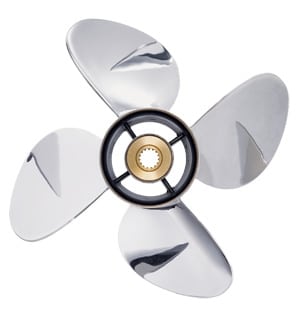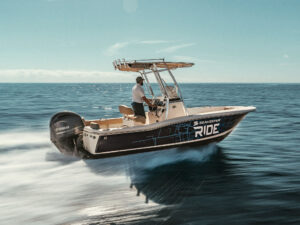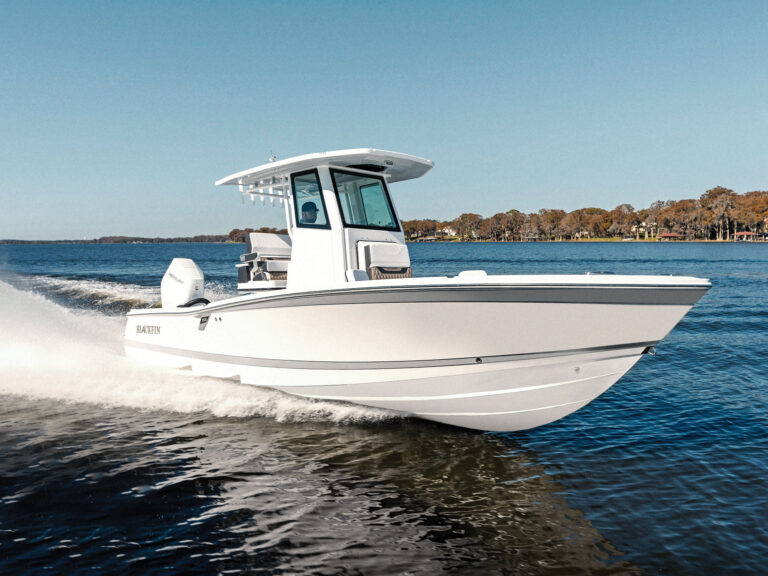
Looks can be deceiving. At first glance, propellers seem like simple forged hunks of metal. But, actually, they are quite complex. Although propping an engine is a routine part of rigging, choosing the right prop is much more complicated. Suggested factory pairings and performance reports are good starting points without a doubt. But to really fine-tune your boat so it runs the way you want it to requires a willingness to experiment.
“You can’t have speed, handling and fuel economy all in one prop. It’s impossible for one design to do it all,” says David Greenwood, product planning manager for Suzuki Outboards. “But you can choose which performance aspects you want most and rig accordingly. Ultimately, the only way to know if a prop is right is to try it during normal operating conditions.”
Props are designated by diameter first, followed by pitch and sometimes blade design. So a 14 x 19 x 3 prop would measure 14 inches in diameter, with 19 inches of pitch and three blades.
While a larger diameter prop pushes more water, pitch has an immediate impact on performance. Lower-pitched props provide better initial acceleration but less top speed. It’s just the opposite with higher pitch: In outboards, each inch of pitch equals approximately 200 rpm. A correctly propped engine will run in the upper end of the wide-open throttle range with a normal to heavy load. Today’s four-stroke outboards are designed to run up to 6,300 rpm without damage, according to Greenwood.
Rake and cup are two other design characteristics to consider. Rake is the angle of the blades in relation to the prop’s center. Typically, a high-rake prop would be used when engines are mounted higher on the transom. Cup is added curves or lips on the tips of the blades. Like rake, cup helps reduce ventilation and increase bow lift. Too much of either, however, can have an adverse effect on engine efficiency.
Adding limited ventilation or air around the propeller blades through vent holes can boost the engine rpm level during hole shots or initial acceleration. Speed can be sacrificed, though, since the blades are not biting “clean” water. In contrast, cavitation occurs when water pressure forms air bubbles. At constant speed, these bubbles will eventually damage the prop.

| | Diameter and pitch should be weighed heavily when choosing a propeller. The diameter is the width of the circle traced by the rotating blade tips. Pitch is the number of inches a propeller would move forward in one full revolution with zero slip.|
The number of blades is yet another variable to consider when selecting a propeller. “Three blades are the most efficient because they swing around quicker and bite fresh water,” explains Dave Meeler with Yamaha Outboards. “They also produce more speed since there is less drag.” For boats like flats skiffs that require more stern and bow lift, along with quick planing capability, a four-blade propeller may be the better choice.
Many inboard-powered boats are switching to five-blade propellers to boost speed and cruising ability, says Robert Martin, the general manager for Bobby Soles Propeller Sales & Service in West Palm Beach, Florida. “Everybody is speed-conscious today,” he says. “Most vessels will cruise at a respectable 30-plus knots.” To handle the rigors of increased diesel horsepower with minimal slippage, many offshore sport-fishing boats use pricey custom wheels with wider blades. Nibral, a nickel, bronze and aluminum alloy, is the material of choice. Custom propellers like the Australian-made Veem brand can cost up to $20,000 each, according to Martin.
The average boater isn’t going to have to spend that much to realize better performance. Many dealers offer propeller demo programs, so you can try various models until you find the one that best matches your expectations and needs. “Determine what’s the most important when you’re on the water,” Mercury’s Ben Duke advises. “Do you want more top-end speed, a better cruise or good fuel economy? Do you need more bow lift or a better hole shot? If so, there’s a propeller out there. It’s just a matter of trial and error to find the right one.”









